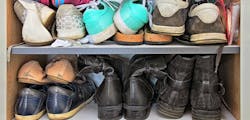Consider: through the years, shoes have become a popular metaphor and storyline, perhaps because they enable you to travel farther than you could without them.
What Secrets Will Your Closet Tell?
My sister, Cindy, said to me, "Look at your shoes to know what kind of person you are and where you’ve been." She added, "You can learn a lot about a person by looking in their closet."
That got me thinking, and the other day as I was putting away my biking shoes, I scanned my closet and was dumbfounded by all the shoes I own. Now, I’m no Imelda Marcos; I have very few dress shoes, but what I have are a lot of shoes with a single function. In addition to my cycling shoes, my specialized shoes include bowling shoes, tennis shoes (just for playing tennis), gym shoes (for working out), running shoes (which I only use for walking — I like the extra cush of running shoes because they are easier on my aging knees), sandals (open and closed-toe versions because I live year-round in them), business casual shoes, and hiking boots to name a few.
Until my feet stopped growing, I pretty much owned only two pairs of shoes: dress shoes for church, and canvas sneakers for school. Otherwise, I didn’t wear shoes at all during the long warm weather months in the South.
During those days, my preferred sneakers were PF Flyers (I recently learned that PF stands for Posture Foundation arch support insole); white canvas wrapped in lots of rubber with a thin blue or red line, and cotton laces. The only reason I preferred them over the other two brands available at the time (Converse and Ked’s), was because of their advertising. The TV commercials claimed that I’d run faster and jump higher, and I believed it.
Now, I don’t know whether it was my belief in the shoes or simply my ability, but I won every 100 yard dash, and long-jump contest whenever I wore those shoes. I’ll never forget the diamond shaped design on the bottom of the soles; they might’ve improved my athleticism, but they were also perfect for collecting mud, (and the devil for getting it back out). My mother was constantly yelling at me for tracking up her kitchen floor.
One day I wore a brand new, gleaming white, pair to school and was bullied mercilessly for it. I had low self-esteem in elementary school, and generally liked to keep a low profile; I never imagined that a new pair of shoes would attract an attack. The older boys who spotted them surrounded me outside the school, and then made a point of ruining their new look. They kicked dirt onto my shoes and stepped on them with their dirty shoes until mine looked like theirs. They would’ve gotten that way on their own within a few days, that newness never lasted long, but the next time my mother bought me a new pair, I made a point of playing in the muddy creek by my house before I would wear them to school.
My feet stopped growing around age 15, and my shoes began to accumulate. I promise I don’t still have any shoes from when I was a teenager. There are some I should eliminate that I’ve kept for nostalgia value. The oldest pair is cowboy boots. I wanted a pair, but you couldn’t find any real western boots in Georgia. On a cross-country trip, when I was 20 years old, I finally found the peg-heeled, super pointy-toed cowboy boots I wanted in Gallup, New Mexico. I loved wearing them, they were great conversation starters, and people commented on them every time I wore them. I’d clearly gotten over my fear of attracting attention to myself with shoes.
Through the years, shoes have become a popular metaphor and storyline, perhaps because they enable you to travel farther than you could without them.
- In folk and fairy tales, shoes represent change, stories such as The Elves and the Shoemaker where the change shoes brought was wealth and prosperity.
- In The Little Glass Slipper, a shoe elevated Cinderella from poverty to royalty.
- And Dorothy’s ruby slippers transported her from Oz back home to Kansas.
- The most powerful fictional shoe scenario I ever read was in The Hunchback of Notre Dame, when Esmeralda is reunited with her mother because of a pair of shoes.
Buying a new pair of shoes can be exciting because they often represent positive changes we are making in our lives: a new job, a vacation, new clothes, or commitment to get better at an activity such as golf or dancing.
As I reviewed my shoe collection, I thought of all the stories they could tell. I paused and picked up my softball cleats which I haven’t used in a few years. The readers of this column know that I’ve been passionate about softball. The last time I wore them was for a Fathers vs. Sons baseball game. I recall that I was the only Dad in the bunch who knew we were going to lose against our 15-year-old sons, (all of whom were training avidly to one day play college or pro ball). I played too hard that day; I wanted to make sure that my son would be as proud of me as the other boys were of their dads. I did well, and made some good defensive plays (even if offensively I never got on base). But, that pride led to a sprained ankle. I was no longer strong enough to play that aggressively in cleats, and while running to catch a pop fly I turned fast and rolled my ankle. I made the catch and finished the game, but within a few days my ankle worsened and I ended up having surgery. Ouch! Hopefully my sense of self has improved since then, and I’ll spend less time worrying about what others think of me. Nowadays, I only play softball in sneakers.
Shoes have generated a number of proverbs. Perhaps the most famous being: Before you judge a man, walk a mile in his shoes. While we may never actually walk in another’s shoes, if we take a moment to imagine what their life is like, then we’ll hopefully come away with some empathy for them and their situation.
On the other hand, I can’t help but laugh at SNL writer, Jack Handey’s version: Before you criticize someone, walk a mile their shoes. That way, you’ll be a mile away from them, and you’ll have their shoes.
In the back of my closet hides a whole row of Birkenstocks. Five pair! I’m reluctant, anymore; to call a shoe ugly because whenever I do it seems that I end up having to wear them. For years I thought Birkenstock sandals were the ugliest shoes I’d ever seen, and I live in sandals, but would never consider wearing those. Then I injured my foot, and my doctor said I needed to wear a high arched insert in my shoes. The inserts were uncomfortable and moved around too much.
We don’t realize how complex the foot is: it is composed of 26 bones, 33 joints, and 100 muscles, tendons and ligaments. If we don’t take care of them, then our choice of shoes becomes limited.
A friend, who still calls himself a hippie, suggested I try Birkenstock sandals because of the built-in arch support. They were perfect, and it was all I wore for years until my foot healed. I learned to love them, and even wore them in the winter with socks. (I’m probably the only person in Georgia to do so.)
One day, on my way to give a speech in Oregon, I got off my plane in the Portland airport. As I stepped into the terminal concourse, a woman who had just exited her plane at the gate across from mine took one look at me and rushed over. She exclaimed, "I’ve been away from Oregon for ten years, and the first person I see is you — a true Oregonian male — wearing Birkenstocks and socks!"
I didn’t have the heart to tell I was from Atlanta, but the next day I opened my speech with the story and concluded by saying, "It’s nice to know that here in Oregon, I blend in." At least until later that afternoon when I got yelled at by a gas station attendant for filling my own gas tank, (until two years ago Oregonians were not allowed to pump their own gasoline).
- What stories do your shoes tell?
- How did they come into your life?
- Where have they taken you?
For more information on Rob, please visit http://www.RobWilsonSpeaker.com.
About the Author

